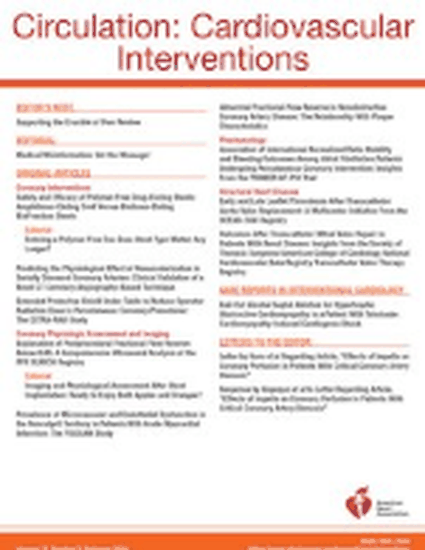
Article
Invasive Versus Echocardiographic Evaluation of Transvalvular Gradients Immediately Post-Transcatheter Aortic Valve Replacement.
Circulation-cardiovascular Interventions
(2019)
Abstract
Transcatheter aortic valve replacement (TAVR) for severe native aortic valve stenosis (native-TAVR) and valve-in-valve TAVR by balloon-expanding and self-expanding platforms is available.1,2 Studies report post-TAVR mean gradients (MG) obtained by aortic valve continuous wave Doppler on echocardiography (echocardiography MG,4V22), without adjusting for noninvasive mean pressure recovery (PRmean) or left ventricular outflow tract MG (LVOT MG,4V12), or invasive MG (catheterization MG) comparison.1,2
Catheterization/echocardiography MG discrepancies exist in aortic valve stenosis due to PR3 and inherent Bernoulli-equation limitations.4 Equations adjusting for these differences are described.3,4 We hypothesized that echocardiography will overestimate post-TAVR MG compared with catheterization.
Institutional Review Board approved the study; authors elect not to make data publicly available.
We retrospectively compared consecutive post-TAVR catheterization and echocardiography MG obtained almost simultaneously (September 2015–September 2018) and studied the impact of LVOT MG and PRmean.
Post-TAVR, a pigtail catheter was reintroduced in the left ventricle for left ventricular pressure. A second transducer was connected to the side-arm of the balloon-expanding TAVR sheath, or the long sheath after removing the self-expanding TAVR valve, for aortic pressure with the sheath-tip positioned in the distal descending aorta to obtain catheterization MG. Echocardiography was performed within 1 to 2 minutes following catheterization measurement.
Disciplines
Publication Date
July 1, 2019
DOI
10.1161/CIRCINTERVENTIONS.119.007973
Citation Information
Abbas AE, Mando R, Hanzel G, Gallagher M, Safian R, Hanson I, Almany S, Pibarot P, Dalal P, Vivacqua A, Sakwa M, Shannon F. Invasive Versus Echocardiographic Evaluation of Transvalvular Gradients Immediately Post-Transcatheter Aortic Valve Replacement. Circ Cardiovasc Interv. 2019 Jul;12(7):e007973. doi: 10.1161/CIRCINTERVENTIONS.119.007973. Epub 2019 Jul 5. PMID: 31272227.
